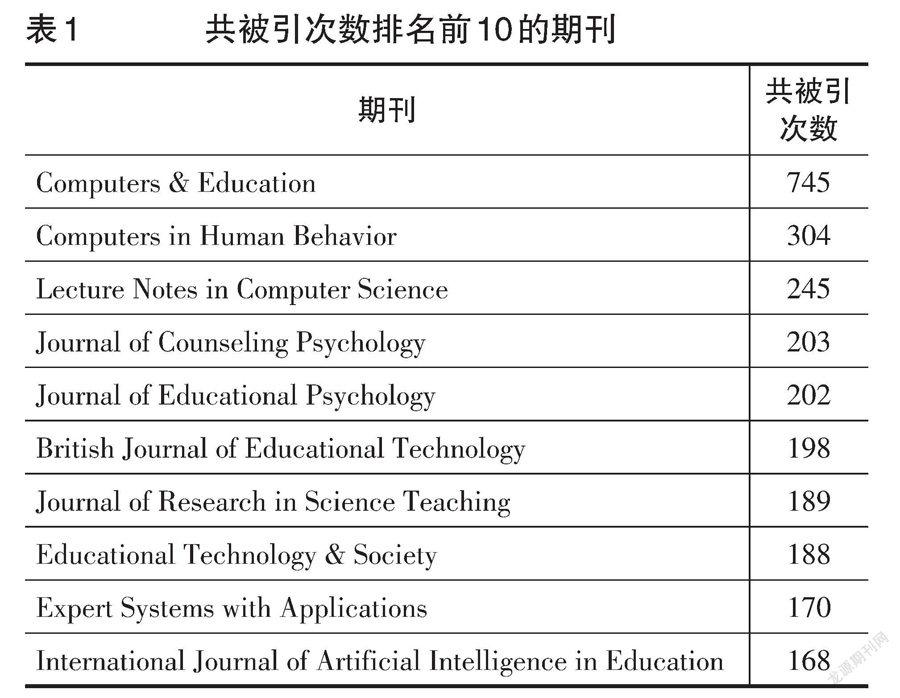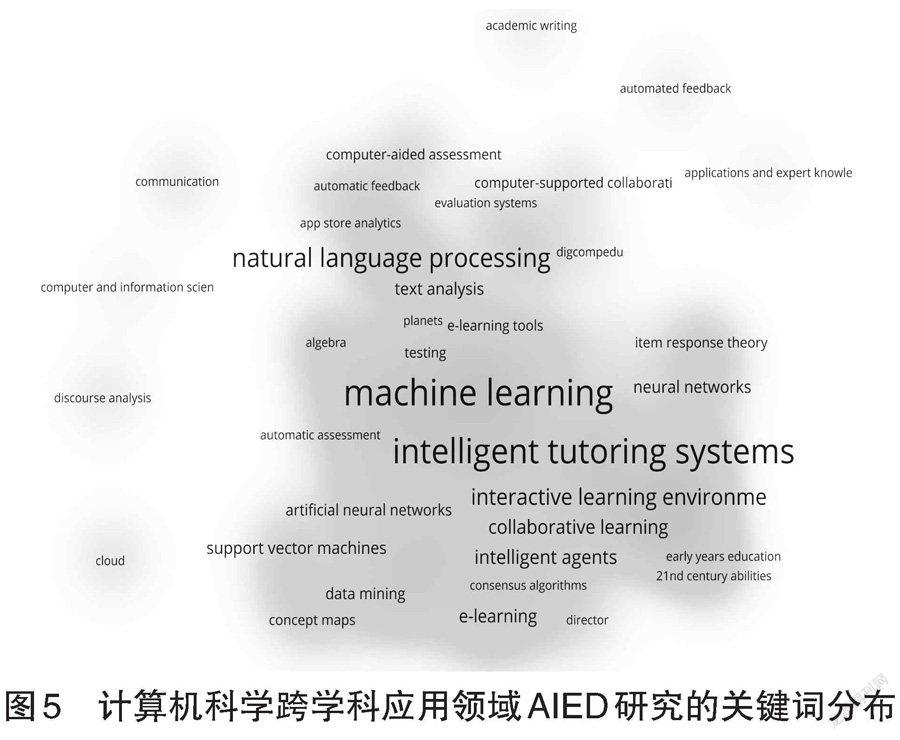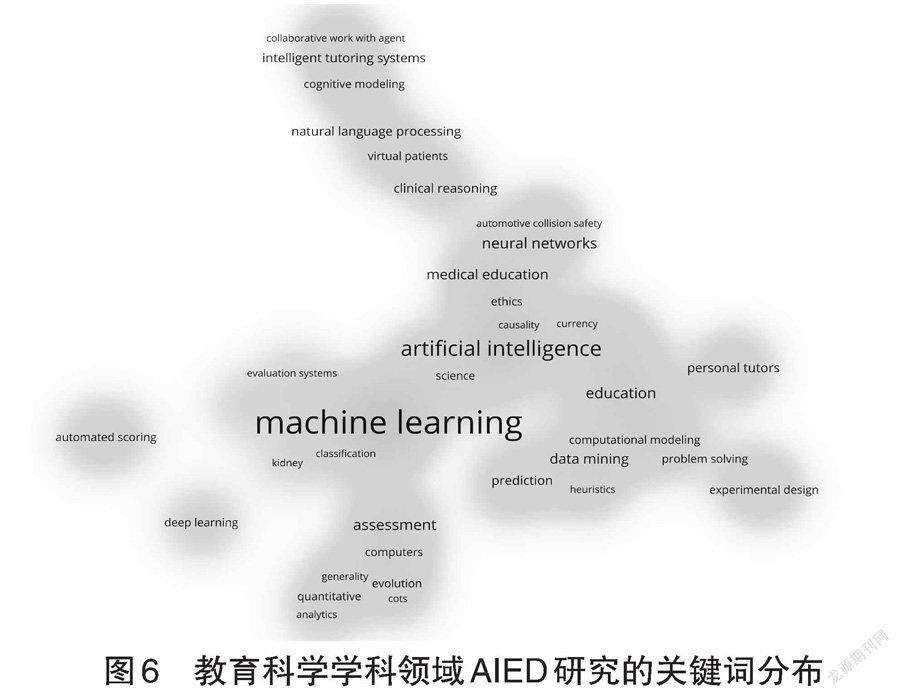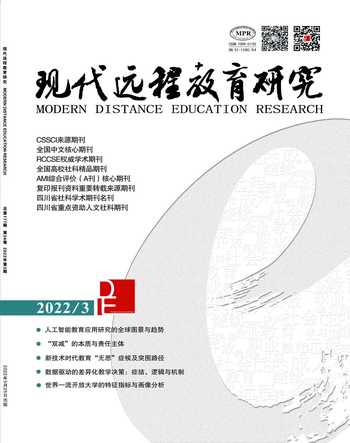人工智能教育应用研究的全球图景与趋势
黄国祯 方建文 涂芸芳









摘要:计算机技术的快速发展促进了人工智能在教育中的应用(AIED)。在人工智能技术的帮助下,计算机可以仿真教师的智能进行推理、判断或预测,为学生提供个性化的指导、支持或反馈,以及协助教师或教育决策者作出决定。尽管AIED已被确定为计算机和教育领域的研究重点,但研究者在进行这种高科技和跨学科的研究时普遍感到具有挑战性。有鉴于此,使用文献计量分析方法,透过对发表在国际高质量期刊的文献进行分析,来了解现阶段AIED的研究热点和发展趋势,能够为研究者提供裨益。从现有研究来看,AIED聚焦机器学习及预测技术在在线学习中的应用、整合自然语言技术的AIED模式、新兴人工智能技术在认知及医学教育中的应用、智能辅导系统的开发与应用、人工智能在教育数据分析中的应用等五大集群,跨越了计算机科学跨学科应用、教育科学学科、心理教育、语言学四大领域,体现出跨学科、多样化的研究图景。未来AIED研究不仅应挖掘大数据和多模态分析等新型技术对教育的作用机制,还应对其传统的研究议题进行多视角、多层面的探索,同时也应积极应对人工智能发展带来的伦理等问题。
关键词:人工智能教育应用;研究热点;趋势分析;文献计量法
中图分类号:G434 文献标识码:A 文章编号:1009-5195(2022)03-0003-12 doi10.3969/j.issn.1009-5195.2022.03.001
基金项目:全国教育科学“十三五”规划2019年度课题“大数据驱动的初中生学业发展监控与精准干预研究”(BCA190089)。
作者简介:黄国祯,博士,教授,博士生导师,台湾科技大学数字学习与教育研究所(台湾台北 106335);方建文,博士,副教授,硕士生导师,温州大学教育学院教育技术系(浙江温州 325035);涂芸芳,博士,助理教授,辅仁大学图书信息学系(台湾新北 242062)。
一、研究背景与目的
人工智能指的是仿真人类智能的计算机系统或技术,例如视觉或音频识别、数据分析、基于数据的判断或决策,以及可以让计算机不断增进智能的机器学习技术(Chen & Xie et al.,2020)。在过去几十年里,由于计算机技术及编程技术的进步,人工智能的研究取得了重大进展。通过传统的机器学习或现代的深度学习等技术,越来越多的产品能够像人类一样思考,并为人类提供“智能服务”(Swinson et al.,2000;Chibani et al.,2013)。例如,有些机器人产品能够通过视觉和音频技术与人进行互动(Alonso-Martin et al.,2013);有些医疗系统能够透过对大量数据的分析协助医护人员判断可能的疾病(Liu et al.,2018)。同时,学者们也开始尝试将人工智能技术应用在教育领域中,例如针对智能辅导系统 (Intelligent Tutoring System, ITS)(Devedzic et al.,2000;Keleş et al.,2009)及自适应学习系统(Adaptive Learning System,ALS)(Hwang et al.,2020a)的开发。
尽管人工智能教育应用(Artificial Intelligence in Education,AIED)具有良好的发展前景,但如何开展AIED研究仍然是一个巨大的挑战(Kay,2012)。这主要因为AIED是一个跨越高科技和教育的跨学科概念。如果研究人员不知道人工智能在教育中的作用以及人工智能技术的运作,可能就无法有效实施AIED的教学活动,更难提出有价值的人工智能教育研究问题。因此,针对相关文献进行系统分析,以提供可能的研究议题及方向,对于研究人员尤其是准备跨入这个领域的新进研究人员来说是非常重要的 (Hwang et al.,2020b)。在分析文献的方法中,文献计量法在近年来受到学界的广泛重视。文献计量法是指对文献的计量数据进行量化分析(Broadus,1987)。随着Web of Science和Scopus等科学数据库的发展,海量文献计量数据的获取变得相对容易,而Gephi和VOSviewer等文献计量软件则可以方便地对这些文献资料进行分析与呈现,因此越来越多的学者开始利用文献计量法来做文献回顾,透过分析大量文献计量数据,以呈现研究主题或领域的知识结构状态和新兴趋势(Donthu et al.,2021)。有鉴于此,本研究尝试运用文献计量法,针对国际知名学术期刊的刊文进行主题及关键词分析,以期全面系统地了解AIED研究的现状,以及面向未来的研究趋势。
二、文献回顾与探讨
随着科技进步和教育发展,如何利用技术支持教师教学和学生学习已成为一个重大的教育研究议题(Hwang et al.,2020b)。人工智能最初以计算机和计算机相关技术的形式出现,智能辅导系统、自适应/个性化学习系统或推荐系统就是AIED的典型应用。早期的人工智能系统可以帮助学生学习。 例如, Pai等(2021)开发了一个用于数字学习的智能辅导系统,该系统不仅能提高学生的数学学习效率,而且也能提高他们的学习积极性。类似的人工智能系统可以帮助学习者高效收集数据,并以“智能”的方式分析和展示数据,以促进他们深入思考并发现数据背后的意义。例如,Hwang等(2011)开发了一个具有交互式概念图机制的移动学习系统,该系统通过评估学生开发的概念图,能为其提供实时提示或学习指导,并帮助他们重新组织和细化所学的知识。
随着网络教育的蓬勃发展,人工智能技术在网络教育中也得到广泛应用。学习场景的变化以及学生人数的快速增长,给教师带来了巨大挑战。为了帮助教师更好地教学,研究人员开发了各种智能工具,用以自动化审查和评价学生的作业,并提供反馈,以此来实现更高质量的教学活动。例如,Cheng(2017)开发了一个具有自动反馈功能的在线写作系统,实验结果显示,通过该系统的自动评分和自动反馈功能能有效提高学生的写作水平。学习环境的变化也给学生带来巨大挑战。为了帮助学生更好地学习,学者们通过收集和分析各种教学数据,并据此为学生提供及时的干预措施。例如,Cetintas等(2009)提出了一种机器学习模型,透过分析学生行为日志中的数据,构建出了不同的学生行为模型。随着学习数据的快速积累,如何分析数据背后的规律成为学者关注的重点。一些学者还利用机器学习和数据挖掘技术采集并分析了学生的学习成绩和学习行为。例如,Guo等(2020)基于深度神经网络技术开发了一个学习系统,利用学生的注视点来评估团队协作,实验结果显示,采用该系统的学生在团队协作和知识保留方面有更好的表现。辍学率也一直是学者关注的热点,Xing等(2019)利用深度学习算法构建了学生辍学预测模型,并运用该模型对 MOOC 中的高危学生进行及时干预。此外,多模态技术和大数据分析还可以为学生在更复杂和开放式學习环境中的学习轨迹捕获与分析提供技术支撑(Blikstein et al.,2016)。例如,Spikol等(2018)利用各种管道(包括计算机视觉、学生用户生成的内容和学习客体等)来记录小组学习者交互的多模态数据,用以帮助教师设计友好的学习环境,以及促进学生的学习反思。
此外,嵌入式计算机系统和新技术的使用也使得移动设备和机器人成为新的教育应用工具(Chen & Chen et al.,2020)。 Kewalramani等(2021)使用人工智能机器人玩具吸引儿童与他人合作,通过让机器人引导儿童与其家人共同创造一个可持续发展的城市,以使他们过上幸福的生活。该研究结果显示,儿童与人工智能机器人游戏有助于培养学生的创造性探究、情感探究和协作探究素养。
综上所述,AIED已成为研究者关注的热点。为了更好地了解AIED的研究现状,本研究运用文献计量分析方法,从文献发表情况、最具影响力的主要期刊与关键词共词分析等方面全景式、可视化呈现该领域的研究样貌,以期为后续研究提供参考。
三、分析方法与研究分布
1.数据源与分析方法
本研究于2022年1月3日透过Web of Science (WOS)的Social Science Citation Index(SSCI)数据库,搜寻截至2021年12月31日学术期刊发表的与AIED相关的文献。文献检索的步骤见图1,检索条件为:Key Words=“artificial intelligence”or“machine intelligence”or“intelligent support”or“intelligent virtual reality”or“chat bot*”or“machine learning”or“automated tutor*”or“personal tutor*”or“intelligent agent*”or“expert system*”or“neural network*”or“natural language processing”or“chatbot*”or“intelligent system”or“intelligent tutor*”(Zawacki-Richter et al.,2019),再经过“文献类型”“领域”“语言”等条件的限定,最后共获得834篇有效文献。
本研究采用文献计量法进行分析,具体包括直接引用(又称“互相引用”)和关键词共词分析(Boyack et al.,2010)。关键词共词分析属于一种共现分析,即为关键词共同出现的关系,最常用来探讨该领域文献之间的主题关系(González-Zamar et al.,2020)。具体而言,采用VOSviewer软件分析期刊与关键词的情况,并将分析结果以可视化图形的方式呈现。VOSviewer软件亦能根据不同关联程度用不同的颜色进行分群,从而让研究者更易于了解不同分群间的发展关系(Van Eck et al.,2010)。
2.AIED研究的分布情况
1987—2021年AIED研究的分布情况见图2。可以看出,前半段时间(1987—2004年),AIED的相关研究文章数量比较少,呈现较平稳的状态,平均每年的发文量是6.9篇。第一篇AIED论文由Yin等(1987)撰写,探讨了机器人、人工智能和计算机模拟三种技术在特殊教育中的应用前景。后半段时间(2005—2021年),AIED研究的文章数量呈现较快速增长,平均每年的发文量达到41.7篇。此外,多数AIED研究主要涵盖了四大领域,分别是“计算机科学跨学科应用”领域(152篇)、 “教育科学学科”领域(111篇)、“心理教育”领域(80篇)和“语言学”领域(51篇)。
四、研究結果与分析
1.学术期刊载文及引用量分析
834篇AIED相关研究刊登于175种期刊上,图3显示了载文量排名前10的期刊,分别为Computers & Education(84篇,被引1990次)、IEEE Transactions on Learning Technologies(54篇,被引559次)、Education and Information Technologies(50篇,被引236次)、Educational Technology & Society(47篇,被引330次)、British Journal of Educational Technology(36篇,被引385次)、Journal of Computer Assisted Learning(22篇,被引270次)、Nurse Education Today(21篇,被引363次)、Journal of Science Education and Technology(19篇,被引185次)、Journal of Educational Computing Research(19篇,被引159次),以及Computer Applications in Engineering Education(14篇,被引158次)。
研究还对共被引次数与引文来源进行了分析,结果显示有82种期刊的最小被引次数超过50次。从表1得知,被引次数排前三名的期刊依序为Computers & Education(共被引745次)、Computers in Human Behavior(共被引304次)与Lecture Notes in Computer Science(共被引245次)。
2.常用关键词分析
关键词具有两项基本功能:一是可以反映文献的研究主题,二是可以透过关键词动态变化了解该领域关注议题的变化趋势(Bodily et al.,2019)。为了解近年来AIED研究反映的主题,研究采用VOSviewer对关键词进行聚类分析。从分析结果得知,2021年之前AIED研究共生成了1995个关键词,其中有107个关键词共同出现4次以上。图4为AIED研究的关键词之分群网络图。
(1)AIED研究领域的五大集群呈现
由图4可知,1987—2021年的AIED研究所探讨的领域主要分为5个集群,分别是机器学习及预测技术在在线学习中的应用、整合自然语言技术的AIED模式、新兴人工智能技术在认知及医学教育中的应用、智能辅导系统的开发与应用,以及人工智能在教育数据分析中的应用。有少许关键词同时出现在两个集群中,但是并不影响每个集群代表的意义,例如在Hwang等(2021)的研究中,智能辅导系统集群和数学教育群集中共同出现了关键词“机器学习”和“智慧辅导”,这表明两个集群除了代表个别的意义外,也可能存在少许共同特质。
集群1为“机器学习及预测技术在在线学习中的应用”,主要关键词涵盖机器学习、在线学习、人工神经网络、评价、协作学习、预测、支持向量机和远程教育等。此集群集中探讨应用机器学习和预测技术开发系统或模型(Chen et al.,2011a)。例如,Pavleković等(2011)开发了基于神经网络的儿童数学天赋预测系统,比较了多层感知器、径向基和概率网络等三种神经网络模型在预测儿童数学天赋方面的表现。此外,此集群也有部分研究讨论如何预测或评价在线学习表现的议题(Lykourentzou et al.,2009a;Beseiso et al.,2021)。例如,Chen(2008)开发了一个基于遗传算法的个性化E-Learning系统, 用以评估学习者的学习过程,并为其提供合适的学习路径。Aydoğdu (2020) 开发了一个基于人工神经网络的在线学习系统,可以依据学生的在线学习行为数据来预测其学业表现。还有部分研究关注学生行为的预测或评价(Chen et al.,2009)。例如,Farhan等(2018)提出了一个基于物联网的交互框架,并开发了一个分析学习者体验的在线系统,用以分析学习者的注意力变化。其中,学生行为预测最常应用于对辍学机率的分析(Lykourentzou et al.,2009b; Urteaga et al.,2020)。例如,Kabathova等(2021)利用不同的机器学习技术分析了学生的相关数据,并有效预测了学生在在线课程中的辍学机率。
集群2为“整合自然语言技术的AIED模式”,主要关键词涵盖自然语言处理、高等教育、数据挖掘、自动评分、专家系统、教育技术、问题解决和计算机辅助教学等。随着自然语言技术的发展,学者们越来越意识到应用自然语言技术解决教育问题的重要性(Odden et al.,2021)。讨论最多的是应用自然语言技术开发学习系统(Jaques et al.,2013;Wu et al.,2013)。例如,Ward等(2013)开发了一个整合自然语言技术的My Science Tutor(MyST)智能辅导系统,通过营造交互式多媒体环境让小学生与虚拟科学导师对话来改善他们的科学学习效果。也有一些学者利用整合自然语言技术的学习系统来支持语言学习(Chen et al.,2011b)。例如,Troussas等(2019)提出了一个用于第二语言学习的智能自适应电子学习系统。还有学者利用整合自然语言技术来支持写作(Lo et al.,2014;Lin et al.,2017)与编程(Yera et al.,2017)。例如,Hsieh等(2013)采用模糊逻辑理论建立了一个个性化的补救学习系统,通过构建合适的学习路径和推荐合适的补习材料,协助学习者评估自己的学习效果,并提供相关学习建议。
集群3为“新兴人工智能技术在认知及医学教育中的应用”,主要关键词涵盖人工智能、神经网络、教育、技术、大数据、医学教育、认知科学、课程和机器人等。随着神经网络和大数据等新兴人工智能技术的发展,其在教育中的应用价值愈加引起学者们的重视。许多学者利用新兴人工智能技术来分析学习者的学习状态。例如,Chatterjee等(2019) 提出了一种基于深度学习的方法来检测文本对话中的情绪——快乐、悲伤和愤怒。Moridis等(2009)利用神经网络来优化学生在在线自我测试期间的情绪状态。另有学者将新兴人工智能技术应用于医学教育。例如,Berner等(2010)探讨了使用诊断决策支持系统时所面临的医学教育问题。Shorey等(2010)使用人工智能的虚拟咨询应用程序来培养学生的临床沟通技能,研究结果显示,使用虚拟患者在教授护理沟通技巧方面具有潜在的价值。还有学者利用神经网络技术和大数据挖掘技术来帮助学生改进学习。例如,Simeunovic等(2014)利用大数据采撷技术创建了一个预测模型,用它预测学生在学期间的表现,并分析影响学生取得成功的因素。此外,人工智能机器人也受到研究者的关注。例如,有学者利用人工智能机器人来培养学生的探究素养(Kewalramani et al.,2021),还有学者运用人工智能机器人来提升学生的学习表现 (Lin et al.,2021)。
集群4为“智能辅导系统的開发与应用”,主要关键词涵盖智能辅导系统、互动学习环境、评价方法、模拟和人机交互接口等。应用智能辅导系统支持学生有效学习是一个重要的研究议题,许多学者开发了智能辅导系统来帮助学生学习(Wu et al.,2013),并促进其能力发展(Hooshyar et al.,2015; Wang et al.,2015)。例如,Roll等(2011)开发了一个几何智能辅导系统,利用自动化和自我调节元认知反馈来改善学生的求助技能。近年来,更多新兴的人工智能技术被应用于智能辅导系统,通过分析学生的状态和行为来为其提供更好的学习支持。例如,Dutt等(2022) 应用模糊神经网络技术来识别学生的状态和学习障碍,用以自动推送合适的学习材料。Hooshyar等(2018)开发了基于在线游戏的贝叶斯智能辅导系统,用以帮助学生提高程序设计能力和基于网络的问题解决能力。
集群5为“人工智能在教育数据分析中的应用”,主要关键词涵盖学习分析、教育数据挖掘、慕课、深度学习、精准预测和分类等。该集群的研究主要采用机器学习(Iatrellis et al.,2021)和神经网络(Guo et al.,2020)等技术。早期的研究倾向于利用传统的人工智能技术对有限的学生学习数据进行分析。例如,Narlı等(2011)在分析了243 名师范生的学习风格和多元智能数据之后,利用决策算法确定了学习风格和多元智能类型之间的关系。随着深度学习技术快速发展,越来越多的学者整合多模态数据融合(Camacho et al.,2020) 和大数据挖掘(Huang et al.,2020)等技术对教育数据进行分析,以期能发掘教育现象背后的规律。此外,许多学者利用教育大数据来分析学生的学习行为(Holmes et al.,2017;Kokoç et al.,2021)并预测学习成绩(Zheng et al.,2022)。 例如,Lee等(2021)创建了两个深度神经网络模型来解决MOOC无法自动评估学生表现的问题,一个可依据学生在MOOC中的学习行为准确评估学生的表现,另一个可根据学生回答练习题的方式有效预测学生的表现。这些实践均表明,人工智能在教育数据分析中的应用有助于教师识别表现不佳的学生,并为其及时提供更多的帮助。
(2)AIED研究跨越四大领域的关键词分析
除了教育研究领域外,研究还针对AIED在计算机科学跨学科应用、教育科学学科、心理教育和语言学等四大领域中涉及的关键词进行分析,以探讨这些领域的研究主题。
图5显示了计算机科学跨学科应用领域AIED研究的关键词分布。其探讨最多的是机器学习和智能辅导系统,其次为自然语言处理。利用机器学习构建学习分析与预测模型是当前研究的热点。例如,Atapattu等(2020)提出了一个可以从学习者的讨论帖子中提取语言和话语特征的机器学习模型,并对学习者进行了分类。Moresi等(2021)构建了两种机器学习模型来评估学习者在学习编程时是否需要帮助。另外,学习过程中的协作也受到一些学者的关注。例如,Zhang等(2021) 设计了一个可以进行口语交流的智能代理,不但可以与孩子一起玩协作益智游戏,还可以自动测量儿童在游戏过程中的任务表现和语言交流行为。
图6显示教育科学学科领域AIED研究的关键词分布。其探讨最多的是机器学习,其次为人工智能和评价等。利用机器学习对学习进行量化评估,以及评估的有效性问题受到学者们的关注。例如,Zhai和Shi等(2021a)对 110 项“机器—人类评分协议”进行了元分析,以确定影响有效评分的因素,其研究结果显示,算法和学科领域对评分成功都有显著的调节作用。Zhai和Krajcik等(2021b)还反思了机器学习如何协助科学教育中的创新评估实践,以及基于机器学习的下一代科学评估的有效性问题。此外,Hernández等(2020) 提出了一个基于过程挖掘技术的评估模型,通过提取学习者在Wiki上协作学习的动态数据,对团队协作的有效性进行了评估。
图7显示了心理教育领域AIED研究的关键词分布。其探讨最多的是机器学习,其次为自然语言处理和人工智能。近年来,通过分析学习者语言或写作语言特征来预测学习者的语言能力受到学者的关注。例如,Sinclair等(2021)使用机器学习技术从 99 名 4~6 年级儿童的言语和写作中提取出语言特征,有效预测了儿童的阅读理解能力。MacArthur等(2019)开发了一个语言结构模型来预测大学生的写作质量,通过分析252 名大学生的议论文语料库,发现衔接和词汇复杂度可以正向预测写作质量,而句法复杂度与写作质量呈负相关。
图8显示了语言学领域AIED研究的关键词分布。其探讨最多的是自然语言处理,其次为智能呼叫和写作评价。近年来受到学者们关注的话题主要有学术写作、句法复杂度和语言学习。例如,Zhu等(2020)开发了一个具有自动评分功能的形成性反馈系统,用以支持学生的科学论证写作,研究结果表明,情境化反馈能有效辅助科学论证写作。Nasseri等(2021)使用三种自然语言处理工具(LCA、TAALED 和 Coh-Metrix)分析了 210 篇论文摘要的语料库, 并对以英语作为第一或第二语言的研究生的学术写作词汇密度和多样性差异进行了比较分析。Nasseri(2021)将整合效应建模和有监督机器学习建模两种预测统计建模方法相结合,用于描述现代英语学术文本的句法从属、一致性和短语结构的特征。Kyle等(2018)利用句子复杂性和短语复杂性的指标对托福作文的语料库进行了分析,并预测了学生的托福作文分数,其结果表明,短语复杂性指标比句子复杂性指标更能预测写作质量。
(3)AIED研究的未来聚焦
从时间维度来看,早期的AIED研究侧重于智能辅导系统( Amaral et al.,2011a)。随着人工智能技术的发展,自然语言处理(Amaral et al.,2011b;Alexopoulou et al.,2017)和人工智能(Jain et al.,2014;Horáková et al.,2017)受到更多的关注。当前学界更加关注机器学习(Webb et al.,2021)。近年来AIED研究议题聚焦精准教育、沟通、机器人和游戏化等。例如,Yang等(2020)提出单信道学习图像识别和三信道学习图像识别两种创新方法,将学生的课程参与转化为图像进行预警预测分析,并与支持向量机、随机森林和深度神经网络等方法进行了对比,结果表明两种方法都可以更加有效地捕获高危学生。Xu等(2021)通过比较儿童与智能对话代理或成人一起陪伴阅读故事书时对故事的理解和口语参与度的差别,结果显示,与智能对话代理一起阅读的儿童对问题的回答具有更好的可理解性,而与成人一起阅读的儿童对问题的回答具有更高的效率,且词汇多样性和主题相关性也较前者更好。
此外,AIED研究还聚焦利用卷积神经网络和深度学习技术对教育实施精准预测和干预。例如,Aydoğdu(2021)基于学生的成绩和来自学习管理系统的学生数据,使用卷积神经网络对学生进行特征分类的准确率超过 80%。Xing等(2019)利用深度学习算法构建了可以准确预测学生辍学概率的模型,并运用该模型对 MOOC 中的高危学生进行了预测和干预。机器人和游戏的议题也受到学者的关注。例如,Chen等(2021)将游戏与Zenbo机器人相结合,以帮助四年级小学生学习汉语成语,其研究结果表明,该方法对男孩更有益,且能更好地提高其学习成就,因为他们的认知负荷明显较低。
五、研究结论与建议
本研究参考Zawacki-Richter等(2019)提出的研究思路,运用文献计量法对1987—2021年发表在SSCI期刊的AIED相关研究进行了系统分析。整体而言,2004年是AIED研究的重要转折之年,1987—2004年间刊发的相关文献数量较少,2004—2021年间刊文数量增长快速,且保持增长趋势。研究基于对关键词及其共现关系进行量化分析,主要获得以下结论:
第一,从关键词的聚类结果得知,当前AIED研究主题聚焦在5个方面:机器学习及预测技术在在线学习中的应用 、整合自然语言技术的AIED模式、新兴人工智能技术在认知及医学教育中的应用、智能辅导系统的开发与应用以及人工智能在教育数据分析中的应用。其中,“机器学习及预测技术在在线学习中的应用”集群的研究主要集中在设计与开发基于人工智能的預测系统上。早期以技术实现和系统开发为主,近年来关注利用最新的机器学习技术来分析学生在线学习的多模态数据,并预测学生的学习行为和学业表现。“整合自然语言技术的AIED模式”集群的研究主要集中在应用自然语言技术开发学习系统上。早期常用于支持科学学习,近年来较多支持语言学习、写作研究和编程学习。“新兴人工智能技术在认知及医学教育中的应用”集群的研究主要聚焦应用新兴人工智能技术促进学生的认知发展。诸多学者利用神经网络技术和大数据技术分析医学院学生的学习行为数据,以促进其更有效的学习。此外机器人在医学教育中的应用也受到关注。“智能辅导系统的开发与应用”集群的研究主要集中在开发智能辅导系统支持学生学习上。随着新技术的发展,近年来智能辅导系统开始应用于支持学生的综合能力提升和高阶思维发展。“人工智能在教育数据分析中的应用”集群的研究主要集中在应用机器学习、神经网络和大数据技术进行数据分析和决策上。早期的研究侧重于对有限的数据进行分析。随着技术的发展,多模态数据融合和大数据挖掘技术受到关注,学者们希望通过大数据来发掘教育现象背后的规律。
第二,AIED跨領域应用主要聚焦在四个方面:一是计算机科学跨学科应用领域,其主要探讨的主题包括机器学习、智能辅导系统、自然语言处理,近年来对数学模型、建模、数据科学教育应用以及协作等问题的探讨逐年增多。二是教育科学学科领域,其最常讨论的主题包括机器学习、人工智能和评价等,近年来量化、科学评估与效度等问题受到研究者的关注。三是心理教育领域,其较多讨论的主题有机器学习、自然语言处理和人工智能,近年来语言特征受到学者们的关注。四是语言学领域,其最常讨论的话题涉及自然语言处理、智能呼叫和写作评价,近年来学术写作、句法复杂度与语言学习受到研究者的关注。
第三,未来AIED研究既要关注新兴技术对教育教学的影响,如透过大数据和多模态技术对学习者的学习行为进行分析,以及根据行为分析对学习者实施精准干预,抑或是预测其学习表现;还应前瞻性地关注因人工智能技术进步而产生的新议题,如积极开展人工智能伦理规范调研,设计和编制相应的课程,不断提升各利益相关者的伦理认知。
第四,一些早期即开始进行的研究议题(如个性化学习),仍会是AIED研究的重要方向。未来在智能手机及平板电脑越来越普及的背景下,人工智能系统将在学习内容、路径、接口、推荐、提示、反馈等方面为学习者提供更加智能化和个性化的学习引导或辅助。此外,人工智能机器人在教育中的应用和人工智能在教育游戏中的应用也不可忽视。
参考文献:
[1]Alexopoulou, T., Michel, M., & Murakami, A. et al. (2017). Task Effects on Linguistic Complexity and Accuracy: A Large-Scale Learner Corpus Analysis Employing Natural Language Processing Techniques[J]. Language Learning, 67(1):180-208.
[2]Alonso-Martin, F., Malfaz, M., & Sequeira, J. et al. (2013). A Multimodal Emotion Detection System During Human-Robot Interaction[J]. Sensors, 13(11):15549-15581.
[3]Amaral, L. A., & Meurers, D. (2011a). On Using Intelligent Computer-Assisted Language Learning in Real-Life Foreign Language Teaching and Learning[J]. ReCALL, 23(1):4-24.
[4]Amaral, L., Meurers, D., & Ziai, R. (2011b). Analyzing Learner Language: Towards a Flexible Natural Language Processing Architecture for Intelligent Language Tutors[J]. Computer Assisted Language Learning, 24(1):1-16.
[5]Atapattu, T., Falkner, K., & Thilakaratne, M. et al. (2020). What Do Linguistic Expressions Tell Us About Learners’ Confusion? A Domain-Independent Analysis in MOOCs[J]. IEEE Transactions on Learning Technologies, 13(4):878-888.
[6]Aydoğdu, Ş. (2020). Predicting Student Final Performance Using Artificial Neural Networks in Online Learning Environments[J]. Education and Information Technologies, 25(3):1913-1927.
[7]Aydoğdu, Ş. (2021). A New Student Modeling Technique with Convolutional Neural Networks: LearnerPrints[J]. Journal of Educational Computing Research, 59(4):603-619.
[8]Berner, E. S., & McGowan, J. J. (2010). Use of Diagnostic Decision Support Systems in Medical Education[J]. Methods of Information in Medicine, 49(4):412-417.
[9]Beseiso, M., Alzubi, O. A., & Rashaideh, H. (2021). A Novel Automated Essay Scoring Approach for Reliable Higher Educational Assessments[J]. Journal of Computing in Higher Education, 33:727-746.
[10]Blikstein, P., & Worsley, M. (2016). Multimodal Learning Analytics and Education Data Mining: Using Computational Technologies to Measure Complex Learning Tasks[J]. Journal of Learning Analytics, 3(2):220-238.
[11]Bodily, R., Leary, H., & West, R. E. (2019). Research Trends in Instructional Design and Technology Journals[J]. British Journal of Educational Technology, 50(1):64-79.
[12]Boyack, K. W., & Klavans, R. (2010). Co-Citation Analysis, Bibliographic Coupling, and Direct Citation: Which Citation Approach Represents the Research Front Most Accurately?[J]. Journal of the American Society for information Science and Technology, 61(12):2389-2404.
[13]Broadus, R. N. (1987). Toward a Definition of “Bibliometrics”[J]. Scientometrics, 12(5):373-379.
[14]Camacho, V. L., de la Guía, E., & Olivares, T. et al. (2020). Data Capture and Multimodal Learning Analytics Focused on Engagement with a New Wearable IoT Approach[J]. IEEE Transactions on Learning Technologies, 13(4):704-717.
[15]Cetintas, S., Si, L., & Xin, Y. P. P. et al. (2009). Automatic Detection of Off-Task Behaviors in Intelligent Tutoring Systems with Machine Learning Techniques[J]. IEEE Transactions on Learning Technologies, 3(3):228-236.
[16]Chatterjee, A., Gupta, U., & Chinnakotla, M. K. et al. (2019). Understanding Emotions in Text Using Deep Learning and Big Data[J]. Computers in Human Behavior, 93:309-317.
[17]Chen, B., Hwang, G. H., & Wang, S. H. (2021). Gender Differences in Cognitive Load When Applying Game-Based Learning with Intelligent Robots[J]. Educational Technology & Society, 24(3):102-115.
[18]Chen, C. M. (2008). Intelligent Web-Based Learning System with Personalized Learning Path Guidance[J]. Computers & Education, 51(2):787-814.
[19]Chen, C. M., & Chen, M. C. (2009). Mobile Formative Assessment Tool Based on Data Mining Techniques for Supporting Web-Based Learning[J]. Computers & Education, 52(1):256-273.
[20]Chen, C. M., & Hsu, S. H. (2011a). Personalized Intelligent Mobile Learning System for Supporting Effective English Learning[J]. Educational Technology & Society, 3:153-180.
[21]Chen, C. M., & Lee, T. H. (2011b). Emotion Recognition and Communication for Reducing Second-Language Speaking Anxiety in a Web-Based One-to-One Synchronous Learning Environment[J]. British Journal of Educational Technology, 42(3):417-440.
[22]Chen, L., Chen, P., & Lin, Z. (2020). Artificial Intelligence in Education: A Review[J]. IEEE Access, 8:75264-75278.
[23]Chen, X., Xie, H., & Hwang, G. J. (2020). A Multi-Perspective Study on Artificial Intelligence in Education: Grants, Conferences, Journals, Software Tools, Institutions, and Researchers[J]. Computers and Education: Artificial Intelligence, 1:100005.
[24]Cheng, G. (2017). The Impact of Online Automated Feedback on Students’Reflective Journal Writing in an EFL Course[J]. The Internet and Higher Education, 34:18-27.
[25]Chibani, A., Amirat, Y., & Mohammed, S. et al. (2013). Ubiquitous Robotics: Recent Challenges and Future Trends[J]. Robotics and Autonomous Systems, 61(11):1162-1172.
[26]Devedzic, V., Debenham, J., & Popovic, D. (2000). Teaching Formal Languages by an Intelligent Tutoring System[J]. Educational Technology & Society, 3(2):36-49.
[27]Donthu, N., Kumar, S., & Mukherjee, D. et al. (2021). How to Conduct a Bibliometric Analysis: An Overview and Guidelines[J]. Journal of Business Research, 133:285-296.
[28]Dutt, S., Ahuja, N. J., & Kumar, M. (2022). An Intelligent Tutoring System Architecture Based on Fuzzy Neural Network (FNN) for Special Education of Learning Disabled Learners[J]. Education and Information Technologies, 27:2613-2633.
[29]Farhan, M., Jabbar, S., & Aslam, M. et al. (2018). IoT-Based Students Interaction Framework Using Attention-Scoring Assessment in E-Learning[J]. Future Generation Computer Systems, 79:909-919.
[30]González-Zamar, M. D., Abad-Segura, E., & Luque de la Rosa, A. et al. (2020). Digital Education and Artistic-Visual Learning in Flexible University Environments: Research Analysis[J]. Education Sciences, 10(11):294.
[31]Guo, Z., & Barmaki, R. (2020). Deep Neural Networks for Collaborative Learning Analytics: Evaluating Team Collaborations Using Student Gaze Point Prediction[J]. Australasian Journal of Educational Technology, 36(6):53-71.
[32]Hernández, J. A. C., Alberico, A. B., & Duarte, M. P. et al. (2020). Teamwork Assessment in Collaborative Projects Through Process Mining Techniques[J]. The International Journal of Engineering Education, 36(1):470-482.
[33]Holmes, M., Latham, A., & Crockett, K. et al. (2017). Near Real-Time Comprehension Classification with Artificial Neural Networks: Decoding E-Learner Non-Verbal Behavior[J]. IEEE Transactions on Learning Technologies, 11(1):5-12.
[34]Hooshyar, D., Ahmad, R. B., & Wang, M. et al. (2018). Development and Evaluation of a Game-Based Bayesian Intelligent Tutoring System for Teaching Programming[J]. Journal of Educational Computing Research, 56(6):775-801.
[35]Hooshyar, D., Ahmad, R. B., & Yousefi, M. et al. (2015). A Flowchart-Based Intelligent Tutoring System for Improving Problem-Solving Skills of Novice Programmers[J]. Journal of Computer Assisted Learning, 31(4):345-361.
[36]Horáková, T., Houška, M., & Dömeová, L. (2017). Classification of the Educational Texts Styles with the Methods of Artificial Intelligence[J]. Journal of Baltic Science Education, 16(3):324-337.
[37]Hsieh, T. C., Lee, M. C., & Su, C. Y. (2013). Designing and Implementing a Personalized Remedial Learning System for Enhancing the Programming Learning[J]. Journal of Educational Technology & Society, 16(4):32-46.
[38]Huang, A. Y., Lu, O. H., & Huang, J. C. et al. (2020). Predicting Students’ Academic Performance by Using Educational Big Data and Learning Analytics: Evaluation of Classification Methods and Learning Logs[J]. Interactive Learning Environments, 28(2):206-230.
[39]Hwang, G. J., & Tu, Y. F. (2021). Roles and Research Trends of Artificial Intelligence in Mathematics Education: A Bibliometric Mapping Analysis and Systematic Review[J]. Mathematics, 9(6):584.
[40]Hwang, G. J., Sung, H. Y., & Chang, S. C. et al. (2020a). A Fuzzy Expert System-Based Adaptive Learning Approach to Improving Students’ Learning Performances by Considering Affective and Cognitive Factors[J]. Computers & Education: Artificial Intelligence, 1:100003.
[41]Hwang, G. J., Xie, H., & Wah, B. W. et al. (2020b). Vision, Challenges, Roles and Research Issues of Artificial Intelligence in Education[J]. Computers & Education: Artificial Intelligence, 1:100001.
[42]Hwang, G. J., Wu, P. H., & Ke, H. R. (2011). An Interactive Concept Map Approach to Supporting Mobile Learning Activities for Natural Science Courses[J]. Computers & Education, 57(4):2272-2280.
[43]Iatrellis, O., Savvas, I. Κ., & Fitsilis, P. et al. (2021). A Two-Phase Machine Learning Approach for Predicting Student Outcomes[J]. Education and Information Technologies, 26(1):69-88.
[44]Jain, G. P., Gurupur, V. P., & Schroeder, J. L. et al. (2014). Artificial Intelligence-Based Student Learning Evaluation: A Concept Map-Based Approach for Analyzing a Student’s Understanding of a Topic[J]. IEEE Transactions on Learning Technologies, 7(3):267-279.
[45]Jaques, P. A., Seffrin, H., & Rubi, G. et al. (2013). Rule-Based Expert Systems to Support Step-By-Step Guidance in Algebraic Problem Solving: The Case of the Tutor PAT2Math[J]. Expert Systems with Applications, 40(14):5456-5465.
[46]Kabathova, J., & Drlik, M. (2021). Towards Predicting Student’s Dropout in University Courses Using Different Machine Learning Techniques[J]. Applied Sciences, 11:3130.
[47]Kay, J. (2012). AI and Education: Grand Challenges[J]. IEEE Intelligent Systems, 27(5):66-69.
[48]Keleş, A., Ocak, R., & Keleş, A. et al. (2009). ZOSMAT: Web-Based Intelligent Tutoring System for Teaching-Learning Process[J]. Expert Systems with Applications, 36(2):1229-1239.
[49]Kewalramani, S., Kidman, G., & Palaiologou, I. (2021). Using Artificial Intelligence (AI)-Interfaced Robotic Toys in Early Childhood Settings: A Case for Children’s Inquiry Literacy[J]. European Early Childhood Education Research Journal, 29(5):652-668.
[50]Kokoç, M., Akçapınar, G., & Hasnine, M. N. (2021). Unfolding Students’ Online Assignment Submission Behavioral Patterns Using Temporal Learning Analytics[J]. Educational Technology & Society, 24(1):223-235.
[51]Kyle, K., & Crossley, S. A. (2018). Measuring Syntactic Complexity in L2 Writing Using Fine-Grained Clausal and Phrasal Indices[J]. The Modern Language Journal, 102(2):333-349.
[52]Lee, C. A., Tzeng, J. W., & Huang, N. F. et al. (2021). Prediction of Student Performance in Massive Open Online Courses Using Deep Learning System Based on Learning Behaviors[J]. Educational Technology & Society, 24(3):130-146.
[53]Lin, C. C., Liu, G. Z., & Wang, T. I. (2017). Development and Usability Test of an E-Learning Tool for Engineering Graduates to Develop Academic Writing in English: A Case Study[J]. Journal of Educational Technology & Society, 20(4):148-161.
[54]Lin, C. J., & Mubarok, H. (2021). Learning Analytics for Investigating the Mind Map-Guided AI Chatbot Approach in an EFL Flipped Speaking Classroom[J]. Educational Technology & Society, 24(4):16-35.
[55]Liu, K., Chen, Z., & Wu, J. et al. (2018). Big Medical Data Decision-Making Intelligent System Exploiting Fuzzy Inference Logic for Prostate Cancer in Developing Countries[J]. IEEE Access, 7:2348-2363.
[56]Lo, H. Y., Liu, G. Z., & Wang, T. I. (2014). Learning How to Write Effectively for Academic Journals: A Case Study Investigating the Design and Development of a Genre-Based Writing Tutorial System[J]. Computers & Education, 78:250-267.
[57]Lykourentzou, I., Giannoukos, I., & Mpardis, G. et al. (2009a). Early and Dynamic Student Achievement Prediction in E-Learning Courses Using Neural Networks[J]. Journal of the American Society for Information Science and Technology, 60(2):372-380.
[58]Lykourentzou, I., Giannoukos, I., & Nikolopoulos, V. et al. (2009b). Dropout Prediction in E-Learning Courses Through the Combination of Machine Learning Techniques[J]. Computers & Education, 53(3):950-965.
[59]MacArthur, C. A., Jennings, A., & Philippakos, Z. A. (2019). Which Linguistic Features Predict Quality of Argumentative Writing for College Basic Writers, and How Do Those Features Change with Instruction?[J]. Reading and Writing, 32(6):1553-1574.
[60]Moresi, M., Gomez, M. J., & Benotti, L. (2021). Predicting Students’ Difficulties From a Piece of Code[J]. IEEE Transactions on Learning Technologies, 14(3):386-399.
[61]Moridis, C. N., & Economides, A. A. (2009). Prediction of Student’s Mood During an Online Test Using Formula-Based and Neural Network-Based Method[J]. Computers & Education, 53(3):644-652.
[62]Narlı, S., Özgen, K., & Alkan, H. (2011). In the Context of Multiple Intelligences Theory, Intelligent Data Analysis of Learning Styles Was Based on Rough Set Theory[J]. Learning and Individual Differences, 21(5):613-618.
[63]Nasseri, M. (2021). Is Postgraduate English Academic Writing More Clausal or Phrasal? Syntactic Complexification at the Crossroads of Genre, Proficiency, and Statistical Modelling[J]. Journal of English for Academic Purposes, 49:100940.
[64]Nasseri, M., & Thompson, P. (2021). Lexical Density and Diversity in Dissertation Abstracts: Revisiting English L1 vs. L2 Text Differences[J]. Assessing Writing, 47:100511.
[65]Odden, T. O. B., Marin, A., & Rudolph, J. L. (2021). How Has Science Education Changed Over the Last 100 Years? An Analysis Using Natural Language Processing[J]. Science Education, 105(4):653-680.
[66]Pai, K. C., Kuo, B. C., & Liao, C. H. et al. (2021). An Application of Chinese Dialogue-Based Intelligent Tutoring System in Remedial Instruction for Mathematics Learning[J]. Educational Psychology, 41(2):137-152.
[67]Pavleković, M., Zekić-Sušac, M., & Đurđević, I. (2011). A Neural Network Model for Predicting Children’s Mathematical Gift[J]. Croatian Journal of Education, 13(1):10-41.
[68]Roll, I., Aleven, V., & McLaren, B. M. et al. (2011). Improving Students’Help-Seeking Skills Using Metacognitive Feedback in an Intelligent Tutoring System[J]. Learning and instruction, 21(2):267-280.
[69]Shorey, S., Ang, E., & Ng, E. D. et al. (2020). Communication Skills Training Using Virtual Reality: A Descriptive Qualitative Study[J]. Nurse Education Today, 94:104592.
[70]Simeunovic, V., & Preradović, L. (2014). Using Data Mining to Predic Success in Studying[J]. Croatian Journal of Educatione, 16(2):491-523.
[71]Sinclair, J., Jang, E. E., & Rudzicz, F.(2021). Using Machine Learning to Predict Children’s Reading Comprehension from Linguistic Features Extracted from Speech and Writing[J]. Journal of Educational Psychology, 113(6):1088-1106.
[72]Spikol, D., Ruffaldi, E., & Dabisias, G. et al. (2018). Supervised Machine Learning in Multimodal Learning Analytics for Estimating Success in Project-Based Learning[J]. Journal of Computer Assisted Learning, 34(4):366-377.
[73]Swinson, M. L., & Bruemmer, D. J. (2000). Expanding Frontiers of Humanoid Robotics[J]. IEEE Intelligent Systems and their Applications, 15(4):12-17.
[74]Troussas, C., Chrysafiadi, K., & Virvou, M. (2019). An Intelligent Adaptive Fuzzy-Based Inference System for Computer-Assisted Language Learning[J]. Expert Systems with Applications, 127: 85-96.
[75]Urteaga, I., Siri, L., & Garofalo, G. (2020). Early Dropout Prediction via Machine Learning in Professional Online Courses[J]. RIED. Revista Iberoamericana de Educación a Distancia, 23(2):147-167.
[76]Van Eck, N. J., & Waltman, L. (2010). Software Survey: VOSviewer, a Computer Program for Bibliometric Mapping[J]. Scientometrics, 84(2):523-538.
[77]Wang, D., Han, H., & Zhan, Z. et al. (2015). A Problem Solving Oriented Intelligent Tutoring System to Improve Students’ Acquisition of Basic Computer Skills[J]. Computers & Education, 81:102-112.
[78]Ward, W., Cole, R., & Bolaños, D. et al. (2013). My Science Tutor: A Conversational Multimedia Virtual Tutor[J]. Journal of Educational Psychology, 105(4):1115-1125.
[79]Webb, M. E., Fluck, A., & Magenheim, J. et al. (2021). Machine Learning for Human Learners: Opportunities, Issues, Tensions and Threats[J]. Educational Technology Research and Development, 69(4):2109-2130.
[80]Wu, P. H., Hwang, G. J., & Tsai, W. H. (2013). An Expert System-Based Context-Aware Ubiquitous Learning Approach for Conducting Science Learning Activities[J]. Journal of Educational Technology & Society, 16(4):217-230.
[81]Xing, W., & Du, D. (2019). Dropout Prediction in MOOCs: Using Deep Learning for Personalized Intervention[J]. Journal of Educational Computing Research, 57(3):547-570.
[82]Xu, Y., Wang, D., & Collins, P. et al. (2021). Same Benefits, Different Communication Patterns: Comparing Children’s Reading with a Conversational Agent vs a Human Partner[J]. Computers & Education, 161:104059.
[83]Yang, Z., Yang, J., & Rice, K. et al. (2020). Using Convolutional Neural Network to Recognize Learning Images for Early Warning of at-Risk Students[J]. IEEE Transactions on Learning Technologies, 13(3):617-630.
[84]Yera, R., & Martínez, L. (2017). A Recommendation Approach for Programming Online Judges Supported by Data Preprocessing Techniques[J]. Applied Intelligence, 47(2):277-290.
[85]Yin, R. K., & Moore, G. B. (1987). The Use of Advanced Technologies in Special Education: Prospects from Robotics, Artificial Intelligence, and Computer Simulation[J]. Journal of Learning Disabilities, 20(1):60-63.
[86]Zawacki-Richter, O., Marín, V. I., & Bond, M. et al. (2019). Systematic Review of Research on Artificial Intelligence Applications in Higher Education-Where Are the Educators?[J]. International Journal of Educational Technology in Higher Education, 16:39.
[87]Zhai, X., Shi, L., & Nehm, R. H. (2021a). A Meta-Analysis of Machine Learning-Based Science Assessments: Factors Impacting Machine-Human Score Agreements[J]. Journal of Science Education and Technology, 30:361-379.
[88]Zhai, X., Krajcik, J., & Pellegrino, J. W. (2021b). On the Validity of Machine Learning-Based Next Generation Science Assessments: A Validity Inferential Network[J]. Journal of Science Education and Technology, 30:298-312.
[89]Zhang, L., Amat, A. Z., & Zhao, H. et al. (2021). Design of an Intelligent Agent to Measure Collaboration and Verbal-Communication Skills of Children with Autism Spectrum Disorder in Collaborative Puzzle Games[J]. IEEE Transactions on Learning Technologies, 14(3):338-352.
[90]Zheng, L., Niu, J., & Zhong, L. (2022). Effects of a Learning Analytics-Based Real-Time Feedback Approach on Knowledge Elaboration, Knowledge Convergence, Interactive Relationships and Group Performance in CSCL[J]. British Journal of Educational Technology, 53:130-149.
[91]Zhu, M., Liu, O. L., & Lee, H. S. (2020). The Effect of Automated Feedback on Revision Behavior and Learning Gains in Formative Assessment of Scientific Argument Writing[J]. Computers & Education, 143:103668.
收稿日期 2022-03-10
International Research Prospects and Trends of Artificial Intelligence in Education
HWANG Gwojen, FANG Jianwen, TU Yunfang
Abstract: The rapid development of computer technology has promoted the application of artificial intelligence in education (AIED). With the artificial intelligence technology, a computer system can simulate teachers’ intelligence to reason, judge or predict as well as provide students with personalized guidance, support or feedback. Moreover, it can assist teachers or educational policy makers to make proper decisions. Although AIED has been identified as a research focus in the fields of computing and education, researchers generally find it challenging to conduct such high-tech and interdisciplinary research. Therefore, it is beneficial for researchers to use bibliometric analysis to understand the hot topics and research trends in AIED through the analysis of research articles published in high-quality international journals. From the analysis results, it is found that AIED research focuses on five major clusters, including machine learning and prediction technologies for online learning, incorporating natural language processing into AI-based educational applications, modern AI in medical and cognitive science education, intelligent tutoring system, and AI in educational data analysis. In addition, these five clusters span four major areas: interdisciplinary application of computer science, educational science disciplines, psychoeducation, and linguistics, reflecting an interdisciplinary and diverse research prospects. In the future, AIED researchers need not only explore the mechanisms of new technologies, such as big data and multimodal analysis for education, but also conduct multi-perspective and multi-faceted exploration of its traditional research topics. Meanwhile, the ethical issues brought about by the use of artificial intelligence in education should also be taken into account.
Keywords: Artificial Intelligence in Education; Hot Research Topics; Trends Analysis; Bibliometric Analysis

